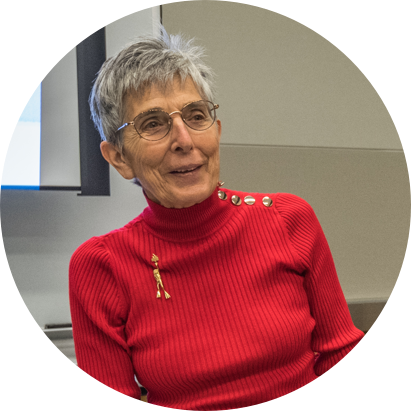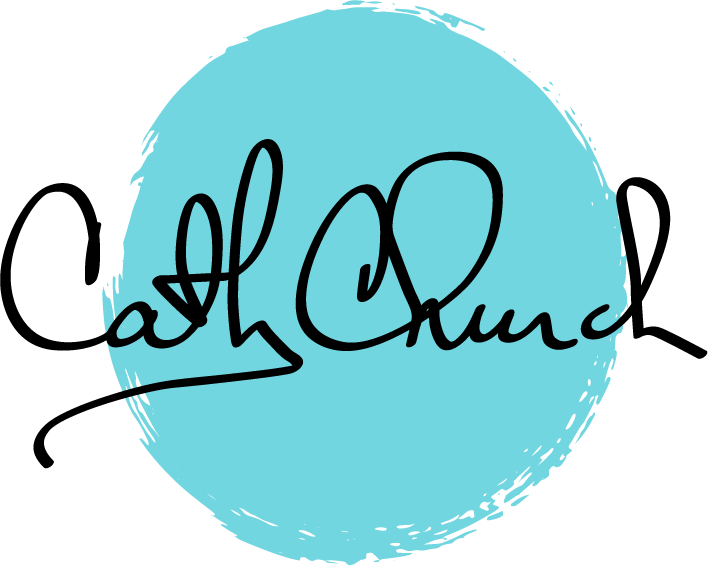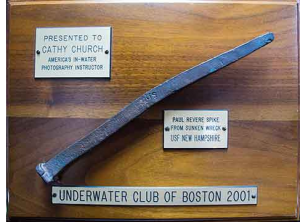Full biography
As a child, Cathy Church was an avid biologist and bird watcher. She earned a BS in biology from the University of Michigan where she learned to SCUBA dive. She was studying marine biology at Stanford University’s Hopkins Marine biology station in Monterey, California when she met Jim Church, a scuba diver who was pioneering underwater photography and writing for Skin Diver Magazine in the early 60s. Cathy wanted to document her underwater work and spent many dives with Jim exploring ways to use the Calypso camera and flashbulb systems with homemade accessories.
She continued on to the University of Hawaii where she earned her MS in Marine biology but in the late 1960s, in Hawaii, she was not able to break the barricades against women divers and she quit pursuing a career as a scientist. Instead, she turned to two other activities—underwater photography and a job teaching 7th and 8th grade science in California.
She quickly became recognized as one of the world’s foremost teachers and authors on underwater photography. Cathy was a photo editor for Skin Diver magazine for 15 years, coauthored hundreds of magazine articles and four books on underwater photo techniques, and offered seminars throughout the USA. Her first week-long photo courses were taught in Grand Cayman in 1972. She developed the first franchised photo courses for dive shops through NASDS.
A versatile photographer, she is well known for many styles of photography from documentary and editorial to the gallery art you see here. She has photographed for many clients including Kodak, Nikon, the US Virgin Islands and the Cayman Islands. Her poster “Wonderland” earned a Certificate of Distinction from Creativity Magazine for best travel poster of the year in 1991. For fourteen years she produced serious black and white photography, spending long days in the darkroom to make her limited edition fine art black and white prints. Her coffee table book “My Underwater Photo Journey” was published in 2004. When hurricane Ivan destroyed her darkroom, and as she developed her digital techniques, she is now producing all of her imagery digitally. After almost fifty years of underwater photography, Cathy is still developing new twists and turns to her photography, adding to her new imagination collection that was released in 2009. She is always keeping up with developments so that she can teach her students the most up-to-date techniques.
She has taught thousands of divers how to enjoy their photography. She still offers seminars throughout the USA and teaches regularly at her underwater photo centre in Grand Cayman. Cathy and Herb Rafael were married in Grand Cayman in 1991. They teach underwater photography and operate Cathy Church’s Photo Centre and Gallery at Sunset House Hotel. Herb’s photos have appeared in Skin Diver Magazine, the cover of Scuba Times, and several other publications as well as advertising campaigns for the U.S. Virgin Islands. Herb handles the marketing and sales, while Cathy concentrates on the photography, teaching and technical side of the photo centre. They both are dedicated to making sure that each customer is best served in whatever way they can.
Cathy’s enthusiasm when she teaches and her kindness toward her students have won her accolades from divers around the world. She encourages people through her writing, her seminars and her classes to enjoy the wonders of the undersea environment. She spends many hours successfully coaching people who are fearful of the water on how to become snorkelers and divers. Her latest book, a coffee table book “My Underwater Photo Journey” is not only a collection of her favorite images from the first forty years of her career, but there are free photo lessons on line for each image. Cathy believes in sharing everything she has learned and she has found many ways to do that.
Like most divers she is a dedicated environmentalist. She spends long hours every week signing petitions, making donations, writing letters to decision makers and supporting environmental causes in any way she can. She became a vegan to reduce her impact on the over-consumption of ocean sea food and the destruction caused by raising cattle and other farm animals.

Cathy’s story
Childhood and college
Cathy Church (nee Catherine Hoffman) was born in 1945, in Altoona, Pennsylvania and moved immediately to southeastern Pennsylvania, remaining in Woodlyn, Ridley Township, until she was 16 years old. She has brothers Denis (deceased), Stephen and Matthew Hoffman and sisters Martha Williamson and Elizabeth Bollinger. She was an honor student and participated in Girl Scouts, music (piano, violin, chorus and can play two melodies on a Ukulele) and many sports, including basketball, lacrosse and field hockey. Her father, a Navy officer in WWII and then a mechanical engineer, moved the family to Michigan where Cathy attended Grand Haven High School in Michigan, active in debate, thespians and music and graduated in 1963.
Due to lack of funds she spent one year at Eastern Michigan until she found a financial sponsor (Leopold Schepp Foundation) so that she could continue for three years at the University of Michigan (continuing to play field hockey for U of M women’s varsity) where she earned her B.S. in biology in 1967. She was introduced to SCUBA diving during summer courses at the U of M biology station at Pelston, MI and took a YMCA class in Ann Arbor with the late Dr. Lee Sommers, (who became a fellow of the Academy of Underwater Arts and Sciences). She attended Stanford University’s Hopkins Marine Biology Station in Monterey, CA for a summer course in Marine Invertebrate Zoology in 1965.
During that time she met Jim Church who was just starting to write for Skin Diver magazine and taught her how to take photographs underwater using a Calypso camera and a twin lens reflex Rollei camera in a Rolleimarin housing, both with flashbulbs. In 1966, she and Jim attended a course in underwater photography at the Brooks Institute of Photography. She completed her Master’s Degree in Marine Zoology at the University of Hawaii in 1970. She married Jim Church in 1969 (he came to Hawaii on sabbatical from teaching high school business classes in Gilroy, CA.) Since women were not allowed overnight on the research ship nor at any research station, she dropped out at the masters level rather than pursuing a PhD. A move which she still wishes she could reconsider. While she loves underwater photography, she REALLY loves the intrigue of science.
Starting a Career
With a degree in marine biology, she wanted to work in an underwater job in California, but women were not being accepted to work as a scuba diver at such places as California State Fish and Game. Since Jim Church was teaching in Gilroy, she was recruited there as a substitute teacher. Since no other work was available, she went to San Jose State College to get a teaching certificate. She taught 7th and 8th grade science in Gilroy from 1971 to 1978.
She and Jim pioneered new techniques for teaching underwater photography. Jim was excellent at organizing the teaching material so that it was clear to their students and readers. Cathy’s interest and skill in science made possible their careful research to make sure that everything they wrote was accurate. For example, she was the first person ever to identify and write about the common mistake that underwater photographers made of aiming a strobe erroneously at the apparent image. It was a simple concept, unknown then, but it is now common knowledge—made clear by their interest in sharing their findings in hundreds of magazine articles.
Jim and Cathy wrote primarily for Skin Diver Magazine, for which they were the contributing photo editors for fifteen years, (from 1970 to 1985). They also wrote four books, “Beginning Underwater Photography” (five editions from 1972 to 1987), “Choosing and Using Underwater Strobes”, “The Nikonos Book” (1979) and “The Nikonos Handbook” (1986). Not only did they write the books, they produced the camera-ready layout in their home, and published the books themselves.
In 1974, they wrote and produced the first underwater photography course for use by a major certifying agency, regrettably NASDS, where John Gaffney usurped the copyright and the course was never updated. Since there were already several major lawsuits against this unscrupulous man, they decided not to pursue their case in court. (Ed Brawley, for example, won his lawsuit against Mr. Gaffney proving that he actually stole the entire “Gold Book,” a complete instructor-training course from Mr. Brawley.) Soon afterward, Jim and Cathy also had difficulty with a photo agency distributing their photos without recognizing the amount payable to them. These bad experiences set the Church duo back quite a bit, and discouraged them from pursuing the use of large agencies as an outlet for their work.
The first SuperCourse
In 1971, Cathy and Jim went to Grand Cayman to visit with friends Ron and Nancy Sefton, who were preparing to build a dedicated dive resort (to become Spanish Bay Reef). The next year the hotel was completed and the Seftons invited them to help the guests at their hotel and Cathy and Jim could stay at no charge. During the first course students shot their first roll of film in black and white, (and then used color slide film), Cathy processed the film, and each student made their own “black and white” studio proof by holding their film and special paper out in the sun until the images showed.
The students had access to Cathy and Jim’s only Marker Buoy extension tube, one housed Vivitar strobe, a Nikonos and a few other items. They did one dive each morning and afternoon, (divers were towed by rope to the nearby dive site at first) and lectures were in the evening. As larger boats were added, the format improved to include long, three-hour shallow dives for plenty of time to take pictures, and afternoon lectures. Thirty years later, Cathy’s SuperCourse offered 15 complete Nikonos systems with many sets of lenses and strobes, the use of a housed system as well as use of a digital system, and still offered the famous long three-hour dives from a boat loaded with tanks, Nitrox, and snacks. This format became very popular and they were almost always full.
With the advent of digital systems, whereby everyone had a different camera, the Super Courses were discontinued in 2005 in favor of smaller, shorter classes that could concentrate on more individual needs.
In 2011, the idea of group instruction was modified for a new style of fun photo vacation at Sunset House —the Cathy Church PhotoFest. This format provided a low-cost vacation for a larger number of participants, a lighter lecture schedule with lots of options from several instructors and of course still offered the same long dives.
Accomplishments and goals
Teaching is Cathy’s true love and she has opened the door to underwater photography for thousands of divers. She organized and taught underwater photography seminars in Seattle, Meadowlands NJ, New York, Philadelphia, Miami, Atlanta, Houston, Denver, Chicago, Los Angeles, San Diego, Columbus OH, Boston, Monterey, CA and more. Cathy has taught more students how to enjoy underwater photography than anyone in the world. She has taught her week-long photo classes yearly in the Cayman Islands (except for four years in the U.S. Virgin Islands) since 1972. Her first lessons, even in 1972, stressed buoyancy control and preservation of the reef. In 1986, she separated from Jim and they were divorced a year later. During the separation, she and Jim continued to teach one last summer session of about six week-long SuperCourses, assisted by Mike Mesgleski. In the first class in 1987, she met Herb Rafael, whom she married in 1991.
Cathy established her own underwater photo center at Sunset House in Grand Cayman in 1988. Her primary efforts still revolve around teaching underwater photography and making sure that divers enjoy their underwater experience. She has superb insight into how the students think and works to teach them individually in ways to which each student can relate.
Always looking for new directions, she is especially concerned that although many people are interested in learning to dive they are too apprehensive and even too afraid to keep up with normal SCUBA instruction. She recently wrote an extensive article about helping the fearful student learn to dive. She has shared it with many who have been excited at what she taught them and are now trying and succeeding to learn to SCUBA.
In another direction, she developed her skill at producing fine art black and white prints. Again, it is her background and love of science that guided her through the complexities of the craft of black and white. Mixing chemicals and working through the zone system was an enjoyable challenge. It was an exciting challenge mixing the craft with the art of underwater photography in black and white. Her darkroom was damaged during Hurricane Ivan in Sept. 2004, and she is now excited by the opportunities to mix the creativity of using Photoshop and printing from a digital format.
Her photography has graced the pages of many underwater and non-diving publications. She has produced beautiful underwater images for numerous advertising clients, including the Cayman Islands Department of Tourism, Kodak, Nikon, various cruise lines, US Virgin Islands, and more. Her underwater prints are available on line and through her gallery in the Cayman Islands. Her coffee table book “My Underwater Photo Journey” was published in 2004.
At the age of 70 she is not only continuing her collection of photos called the “Imagination Collection” where it no longer matters “what” the photo is, but only “what it looks like to you and your imagination.” But she is adding an entirely new dimension in her fantasy collection, made through various styles including a lot of photoshop. She says that she is looking forward to another twenty-five years of helping others take better photographs underwater.














